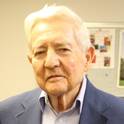
The pioneering investigation of Jacobs and Mirkus (1) showed that substantial amounts of sulfur could be removed from Illinois No. 6 coal by treatment with mixtures of air, nitrogen, and steam in a fluidized bed reactor at moderately elevated temperatures. Thus by treating coal, which had been ground in a hammer mill (100% through 8-mesh screen), with a gas mixture containing 2.7% oxygen, 35% steam, and 62.3% nitrogen at 510°C for 30 min, the sulfate and pyritic sulfur content of the solids was reduced about 80% and the organic sulfur content 10%. However, at the same time the content of combustible volatile matter was reduced about 65%. Desulfurization improved with increasing residence time and decreasing particle size, but it was affected only slightly by oxygen concentrations in the range of 2-10% or steam concentrations in the range of 0-85%. The sulfur content of the char declined as the treatment temperature.
Available at: http://works.bepress.com/thomas-wheelock/37/

Reprinted (adapted) with permission from Coal Desulfurization Chapter 23, pp 305–320 DOI: 10.1021/bk-1977-0064.ch023. Copyright 1977 American Chemical Society.